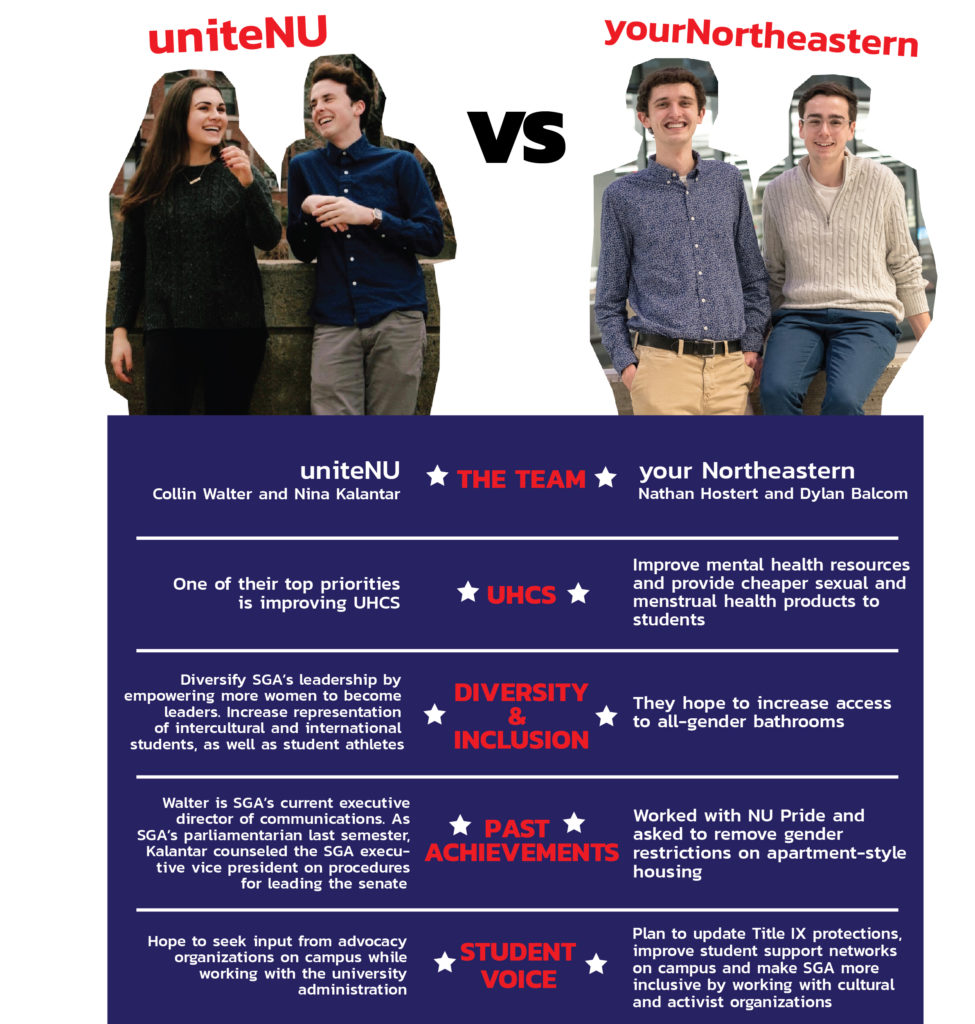Column: ‘Diversity in leadership’ needs to be more nuanced
Key student issues such as UHCS, diversity and student involvement in decision-making were the main topics of the March 14 SGA debate. / Graphic by Michelle Lee
March 28, 2018
When the student body elected President Suchira Sharma and Executive Vice President Paulina Ruiz, it was historic. Both Sharma and Ruiz are women of color, and their election broke Northeastern’s “glass ceiling.”
It’d be easy to say the election of Nathan Hostert and Dylan Balcom, two white men, was a step backward. However, Hostert and Balcom are both openly gay, and their platform proposed housing and health policies that would benefit all students, but specifically addressed the challenges faced by LGBTQA+ people. After Monday’s Senate meeting, Balcom said he and Hostert don’t want their sexuality to just be a talking point. Instead, they want it to be something that drives them to create inclusive policies that benefit Northeastern’s student body.
UniteNU, the losing slate which Sharma and Ruiz endorsed, presented another white man running for president. However, it could be argued that presidential candidate Collin Walter, SGA’s current executive director of communications, designed the most inclusive and engaging communications strategy SGA has ever had. At the same time, Hostert established SGA’s Diversity and Inclusion subcommittee this year. But Walter’s running mate, Nina Kalantar, is an Iranian-American Muslim woman who was SGA’s top procedure expert as parliamentarian this year. Hostert and Balcom both grew up in conservative areas, and understand the impact that exclusion and identity-based prejudice have on students.
Who’s more “diverse?” More “groundbreaking?” More “representative?”
Realistically, it shouldn’t matter. While diversity and inclusion is at the heart of making better policy that is fair to all students, debate over who can list the most marginalized identities or the most engagement with marginalized groups doesn’t necessarily foster it.
In a nation built on systematic oppression — of people of color, of women, of LGBTQA+ people and of religious minorities — policies have an aggressive tendency to be exclusionary if there are not diverse voices in the room. If diverse voices create diverse policy, then different types of diversity each have their own value.
While diversity in beliefs is rarely discussed, perhaps because people associate it with politics, Walter believes it’s important — just like diversity in gender identity, sexuality, race and ethnicity are important. Many of SGA’s leadership positions are appointed; therefore the president and executive vice president have the ability — and perhaps responsibility — to prioritize diversity in leadership with the goal of creating inclusive policy and procedures.
White men hold a disproportionate amount of power in most organizations. More people who aren’t white men should be getting elected to leadership positions — this is undeniable.
However, when two white men are up for election, let’s not crucify them. We also shouldn’t vote no confidence, which would result in the Senate choosing a slate. Almost 25 percent of voters did so this year, but everyone agrees that the Senate isn’t as representative of the student body as it should be, so why give them that power?
Moving forward, we should consider that diversity is more complex than race and gender, and push for policy that creates an inclusive environment for all beliefs (that aren’t based in hate or prejudice) and identities.







